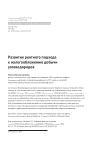The impact of government support measures on the innovative activity of companies in the Russian Federation
DOI: 10.33917/mic-2.115.2024.5-22
The scientific article presents the advanced experience of leading foreign countries to activate innovation. It was established that mainly organizations for the development of innovation use direct and indirect support measures. The principles of activation and support of innovative activities in foreign countries are shown, the main tools for state stimulation and activation of innovation in foreign countries have been identified.
References:
1. Order of the President of the Russian Federation dated March 30, 2002 No. Pr-576 «Fundamentals of the policy of the Russian Federation in the field of development of science and technology for the period until 2010 and beyond». URL: www.consultant.ru
2. «The main directions of the policy of the Russian Federation in the field of development of the innovation system for the period until 2010» (approved by the Government of the Russian Federation on 05.08.2005 No. 2473p-P7). URL: www.consultant.ru
3. Strategy for the development of science and innovation in the Russian Federation for the period until 2015 (approved by the Interdepartmental Commission on Scientific and Innovation Policy (protocol dated February 15, 2006 No. 1). URL: www.consultant.ru
4. Order of the Government of the Russian Federation of July 4, 2023 No. 1789-r «On approval of a comprehensive scientific and technical program of a full innovation cycle “New composite materials: design and production technologies”». URL: www.consultant.ru
5. Kalinov V.V. Formation of the conceptual foundations of the innovation policy of the Russian Federation. Bulletin of Tomsk State University.2011;4(16):16-43. (In Russ.).
6. Bondarenko N.E. Innovative development of the Russian economy: retrospective analysis and prospects. International scientific journal “INNOVATIVE SCIENCE”. 2015;11:32-38. (In Russ.).
7. Ustinova L.N., Ustinov A.E. Modern problems of innovative development of an enterprise Russian entrepreneurship. 2018;19(2):432-444. (In Russ.).
8. Lavrinenko A.R. Diagnostics and directions of development of the innovative potential of scientific and technical entrepreneurship. Bulletin of Polotsk State University. Series D. Economic and legal sciences. 2022;12:35-42. (In Russ.).
9.Suglobov A.E. The essence of innovative activity of economic entities in modern conditions of economic development. Bulletin of the Moscow University of the Ministry of Internal Affairs of Russia. 2013;8:194-199. (In Russ.).
10. Kozhitov L.V., Zaporotskova I.V., Kozlov V.V. Promising carbon-based materials. Bulletin of VolSU. 2009-2010;10(4):63-84. (In Russ.).
11. Kolobkov A.S. Development of technologies for producing carbon fibers (review). PROCEEDINGS OF VIAM / TRUDY VIAM. 2022; 8 (114):123-131. (In Russ.).
12. Khasanova G.B. Principles of «Green engineering» – a promising way to solve the problem of environmental pollution with polymersю Bulletin of the Kazan Technological University. 2013;22. (In Russ.).
13. Rogov V.A., Shkarupa M.I., Velis A.K. Classification of composite materials and their role in modern mechanical engineering. Vestnik RUDN. Series: Engineering Research. 2012;2:41-49. (In Russ.).











